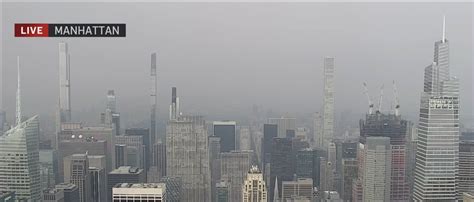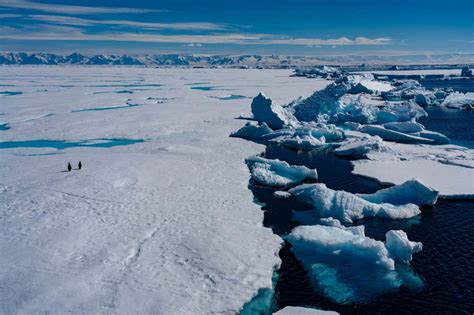
Hazardous air quality alerts have been issued across a wide swath of the United States as smoke from hundreds of active wildfires in Canada continues to drift south, impacting millions of Americans. The Environmental Protection Agency (EPA) and local authorities are urging residents, especially those with respiratory issues, children, and the elderly, to take precautions to minimize exposure.
Canadian Wildfires Trigger US Air Quality Crisis
Smoke from over 400 active wildfires raging across Canada is severely impacting air quality in numerous U.S. states, prompting health advisories and widespread concern. The unprecedented scale of the fires, fueled by dry conditions and high temperatures, has created a transboundary pollution event, blanketing major metropolitan areas and rural communities alike in a thick haze.
The EPA’s AirNow.gov website shows air quality index (AQI) values reaching hazardous levels in several locations, particularly in the Northeast and Midwest. “When air quality is unhealthy, it is particularly important for sensitive groups such as children, the elderly, and those with heart and lung conditions to reduce their exposure,” the EPA warns.
Extent of the Impact
The smoke plume is so extensive that it has been detected as far south as the Carolinas and westward into the Plains states. Cities like New York City, Philadelphia, Chicago, and Detroit have experienced significantly reduced visibility and elevated levels of particulate matter, specifically PM2.5, which poses the greatest risk to human health.
PM2.5 refers to fine inhalable particles with diameters of 2.5 micrometers or smaller, which can penetrate deeply into the lungs and even enter the bloodstream. Exposure to elevated levels of PM2.5 can trigger or exacerbate respiratory illnesses such as asthma, bronchitis, and chronic obstructive pulmonary disease (COPD). It can also increase the risk of heart attacks and strokes.
The severity of the air quality impact varies by region, depending on proximity to the fires and prevailing wind patterns. Areas closer to the source are experiencing the most acute effects, while those further away may still be subject to unhealthy air quality conditions.
Health Recommendations and Precautions
Health officials are strongly advising residents in affected areas to take the following precautions:
- Limit outdoor activities: Reduce strenuous activities outdoors, especially during peak smoke hours.
- Stay indoors: Keep windows and doors closed to prevent smoke from entering homes and buildings. Use air purifiers with HEPA filters to remove particulate matter from indoor air.
- Wear a mask: If you must be outdoors, wear a NIOSH-approved N95 respirator mask to filter out fine particles. Surgical masks and cloth masks offer limited protection against PM2.5.
- Monitor air quality: Stay informed about local air quality conditions by checking the AirNow.gov website or using a reliable air quality app.
- Seek medical attention: If you experience symptoms such as coughing, wheezing, shortness of breath, chest pain, or eye irritation, consult a healthcare professional.
- Protect vulnerable populations: Ensure that children, the elderly, and individuals with pre-existing respiratory or cardiovascular conditions are taking extra precautions.
Causes and Contributing Factors
The Canadian wildfires are attributed to a combination of factors, including:
- Climate change: Rising temperatures and prolonged periods of drought have created ideal conditions for wildfires to ignite and spread rapidly.
- Dry conditions: Many parts of Canada have experienced below-average rainfall and higher-than-normal temperatures in recent months, leading to dry vegetation that serves as fuel for fires.
- Lightning strikes: Lightning strikes are a natural cause of wildfires, particularly in remote areas.
- Human activity: Human-caused ignitions, such as unattended campfires or improperly discarded cigarettes, can also contribute to the problem.
The scale of the wildfires is unprecedented, with authorities struggling to contain the blazes due to the vastness of the affected areas and the challenging terrain. Resources from across Canada and other countries have been mobilized to assist with firefighting efforts.
Long-Term Outlook
The duration of the air quality crisis in the U.S. depends on several factors, including the intensity and location of the wildfires, weather patterns, and firefighting efforts. Experts predict that smoke impacts could persist for several days or even weeks, depending on how quickly the fires can be brought under control.
“The situation is dynamic, and air quality conditions can change rapidly,” the EPA notes. “It is important to stay informed and take precautions to protect your health.”
The long-term implications of the Canadian wildfires extend beyond air quality concerns. The fires are also causing significant damage to forests, wildlife habitats, and infrastructure. They are releasing massive amounts of greenhouse gases into the atmosphere, further contributing to climate change.
Economic Impacts
The air quality crisis is also having economic impacts, affecting businesses, tourism, and outdoor recreation. Many outdoor events have been canceled or postponed due to the unhealthy air conditions. Businesses with outdoor operations, such as restaurants and construction companies, are experiencing disruptions.
The tourism industry is also suffering, as visitors cancel trips to affected areas due to concerns about air quality. The economic losses associated with the wildfires are expected to be substantial, both in Canada and the United States.
International Cooperation
The Canadian wildfires highlight the need for international cooperation to address the growing threat of wildfires. Climate change is increasing the frequency and intensity of wildfires around the world, posing significant challenges to communities and ecosystems.
Countries need to work together to reduce greenhouse gas emissions, implement sustainable forest management practices, and improve wildfire prevention and suppression efforts. Sharing resources and expertise is crucial to effectively combat wildfires and mitigate their impacts.
Government Response
Both the U.S. and Canadian governments are taking steps to address the wildfire crisis. In Canada, federal and provincial authorities are coordinating firefighting efforts and providing support to affected communities. The Canadian government has also pledged to invest in climate change mitigation and adaptation measures.
In the U.S., the EPA is working with state and local agencies to monitor air quality and provide guidance to the public. The federal government is also providing assistance to Canada in the form of firefighting resources and personnel.
Community Resilience
Communities affected by the wildfires are demonstrating remarkable resilience in the face of adversity. Neighbors are helping neighbors, and volunteers are providing support to those in need. The outpouring of generosity and compassion is a testament to the strength of the human spirit.
However, the long-term impacts of the wildfires will be significant, and communities will need ongoing support to recover and rebuild. Addressing the underlying causes of wildfires, such as climate change and unsustainable land management practices, is essential to prevent future disasters.
The Future of Wildfires
The Canadian wildfires serve as a stark reminder of the growing threat of wildfires in a changing climate. As temperatures continue to rise and droughts become more frequent, wildfires are likely to become more common and more intense.
Taking action to reduce greenhouse gas emissions is crucial to mitigating the risk of future wildfires. Implementing sustainable forest management practices, such as thinning forests and prescribed burning, can also help to reduce the risk of wildfires.
Investing in wildfire prevention and suppression efforts is essential to protecting communities and ecosystems. This includes improving early detection systems, training firefighters, and providing resources to support firefighting operations.
Individual Actions
Individuals can also play a role in reducing the risk of wildfires. By taking precautions to prevent human-caused ignitions, such as properly extinguishing campfires and avoiding the use of fireworks in dry areas, individuals can help to protect their communities.
Supporting policies and initiatives that address climate change and promote sustainable land management practices is also important. By working together, individuals, communities, and governments can help to reduce the risk of wildfires and protect the environment.
Ongoing Monitoring and Assessment
The situation remains fluid, and ongoing monitoring and assessment are essential to understand the full extent of the impact of the Canadian wildfires. Scientists are studying the effects of the smoke on air quality, human health, and ecosystems.
Researchers are also working to improve wildfire prediction models and develop new technologies for wildfire prevention and suppression. The knowledge gained from these efforts will be critical to mitigating the risk of future wildfires and protecting communities.
Focus on Vulnerable Populations
The impact of the Canadian wildfires is not felt equally across all populations. Vulnerable groups, such as children, the elderly, individuals with pre-existing respiratory or cardiovascular conditions, and low-income communities, are disproportionately affected.
These groups are more likely to experience adverse health effects from exposure to wildfire smoke and may have limited access to resources to protect themselves. Targeted interventions are needed to address the specific needs of vulnerable populations.
This includes providing access to clean air shelters, distributing N95 masks, and offering education and outreach programs. Ensuring that all members of the community have the resources they need to protect themselves is essential to promoting equity and resilience.
Psychological Impacts
The Canadian wildfires and the resulting air quality crisis are also having psychological impacts on individuals and communities. The stress and anxiety associated with the threat of wildfires, the disruption of daily life, and the health concerns related to smoke exposure can take a toll on mental health.
Providing mental health support services is crucial to helping individuals and communities cope with the psychological impacts of the wildfires. This includes offering counseling, support groups, and educational resources. Promoting resilience and fostering a sense of community can also help to mitigate the psychological effects of the disaster.
Adapting to the New Normal
The Canadian wildfires may be a sign of things to come. As climate change continues to exacerbate the risk of wildfires, communities need to adapt to the new normal. This includes developing strategies to protect homes and businesses from wildfires, improving emergency preparedness, and building community resilience.
Investing in infrastructure that can withstand the impacts of wildfires, such as fire-resistant building materials and improved water supplies, is also important. By taking proactive steps to adapt to the changing climate, communities can reduce their vulnerability to wildfires and protect their future.
A Call to Action
The Canadian wildfires are a call to action. They underscore the urgent need to address climate change and implement sustainable land management practices. They highlight the importance of international cooperation and community resilience.
By working together, we can reduce the risk of future wildfires and protect our communities and ecosystems. The time to act is now. We must take bold and decisive steps to address the underlying causes of wildfires and build a more sustainable future for all.
Air Quality Index (AQI) Explained
The Air Quality Index (AQI) is a tool used by the EPA and other agencies to communicate air quality conditions to the public. The AQI ranges from 0 to 500, with higher values indicating poorer air quality. The AQI is based on the concentrations of five major air pollutants:
- Ozone (O3): A gas that can irritate the lungs and cause respiratory problems.
- Particulate matter (PM2.5 and PM10): Fine particles that can penetrate deeply into the lungs and bloodstream.
- Carbon monoxide (CO): A colorless, odorless gas that can reduce the amount of oxygen in the blood.
- Sulfur dioxide (SO2): A gas that can irritate the lungs and cause respiratory problems.
- Nitrogen dioxide (NO2): A gas that can irritate the lungs and cause respiratory problems.
The AQI is divided into six categories:
- Good (0-50): Air quality is satisfactory, and air pollution poses little or no risk.
- Moderate (51-100): Air quality is acceptable; however, for some pollutants there may be a moderate health concern for a very small number of people who are unusually sensitive to air pollution.
- Unhealthy for Sensitive Groups (101-150): Members of sensitive groups may experience health effects. The general public is not likely to be affected.
- Unhealthy (151-200): Everyone may begin to experience health effects; members of sensitive groups may experience more serious effects.
- Very Unhealthy (201-300): Health alert: everyone may experience more serious health effects.
- Hazardous (301-500): Health warning of emergency conditions: everyone is more likely to be affected.
When the AQI is in the Unhealthy for Sensitive Groups, Unhealthy, Very Unhealthy, or Hazardous range, it is important to take precautions to protect your health. This includes limiting outdoor activities, staying indoors, and wearing a mask.
The Science of Wildfire Smoke
Wildfire smoke is a complex mixture of gases and particles released by the burning of vegetation and other materials. The composition of wildfire smoke depends on several factors, including the type of fuel being burned, the temperature of the fire, and the weather conditions.
The primary pollutants in wildfire smoke are particulate matter (PM2.5 and PM10), carbon monoxide, ozone precursors (such as volatile organic compounds and nitrogen oxides), and toxic air contaminants (such as benzene and formaldehyde).
PM2.5 is the pollutant of greatest concern in wildfire smoke because it can penetrate deeply into the lungs and bloodstream, causing a range of health problems. Exposure to PM2.5 can trigger or exacerbate respiratory illnesses, increase the risk of heart attacks and strokes, and even lead to premature death.
The health effects of wildfire smoke depend on the concentration of pollutants, the duration of exposure, and the individual’s health status. Children, the elderly, and individuals with pre-existing respiratory or cardiovascular conditions are particularly vulnerable to the health effects of wildfire smoke.
FAQ: Canadian Wildfire Smoke Impacting the US
1. What are the primary health risks associated with the Canadian wildfire smoke?
The main health risk comes from the high concentration of particulate matter, specifically PM2.5, in the smoke. These tiny particles can penetrate deep into the lungs and bloodstream, causing or exacerbating respiratory illnesses like asthma and bronchitis, increasing the risk of heart attacks and strokes, and potentially leading to premature death, particularly for vulnerable populations like children, the elderly, and those with pre-existing heart and lung conditions. According to the EPA, “When air quality is unhealthy, it is particularly important for sensitive groups such as children, the elderly, and those with heart and lung conditions to reduce their exposure.”
2. How can I protect myself from the wildfire smoke?
To protect yourself, limit outdoor activities, especially strenuous ones, and stay indoors with windows and doors closed. Use air purifiers with HEPA filters to remove particulate matter. If you must go outside, wear a NIOSH-approved N95 respirator mask. Surgical masks and cloth masks provide limited protection. Monitor local air quality reports and seek medical attention if you experience symptoms like coughing, wheezing, or shortness of breath.
3. How long will the air quality be affected by the wildfire smoke?
The duration of the air quality crisis is uncertain and depends on the intensity and location of the wildfires, weather patterns, and firefighting efforts. Experts predict that smoke impacts could persist for several days or even weeks. “The situation is dynamic, and air quality conditions can change rapidly,” the EPA notes, emphasizing the need to stay informed.
4. What is the Air Quality Index (AQI) and how should I interpret it?
The AQI is a tool used to communicate air quality levels. It ranges from 0 to 500, with higher numbers indicating worse air quality. Levels between 0-50 are considered “Good,” 51-100 “Moderate,” 101-150 “Unhealthy for Sensitive Groups,” 151-200 “Unhealthy,” 201-300 “Very Unhealthy,” and 301-500 “Hazardous.” When the AQI is above 100, sensitive groups should take precautions. Above 150, everyone may experience health effects. You can find the AQI for your area on AirNow.gov.
5. What are the long-term implications of these wildfires, beyond just the air quality?
The long-term impacts extend beyond air quality. The fires are causing significant damage to forests, wildlife habitats, and infrastructure. They are releasing massive amounts of greenhouse gases, further contributing to climate change. Economically, businesses, tourism, and outdoor recreation are affected. The fires also highlight the need for international cooperation to address climate change and improve wildfire prevention and suppression efforts. Furthermore, the psychological impacts on individuals and communities can be significant, requiring mental health support services.
Understanding PM2.5 and its Impact
Particulate Matter 2.5 (PM2.5) refers to fine inhalable particles with diameters that are 2.5 micrometers or smaller. To put this in perspective, a human hair is about 70 micrometers in diameter, meaning PM2.5 particles are roughly 30 times smaller. This minute size is what makes them so dangerous to human health.
How PM2.5 Affects the Body:
-
Respiratory System: When inhaled, PM2.5 particles can bypass the body’s natural defense mechanisms, such as nasal hairs and mucus, and travel deep into the lungs. They can irritate and inflame the airways, leading to coughing, wheezing, shortness of breath, and exacerbation of respiratory conditions like asthma, bronchitis, and COPD.
-
Cardiovascular System: PM2.5 particles can cross the air-blood barrier in the lungs and enter the bloodstream. Once in circulation, they can trigger inflammation and oxidative stress, damaging blood vessels and increasing the risk of blood clots. This can lead to heart attacks, strokes, and other cardiovascular problems.
-
Other Health Effects: Emerging research suggests that PM2.5 exposure may also be linked to other health problems, including developmental issues in children, neurological disorders, and even cancer.
Sources of PM2.5:
PM2.5 can come from a variety of sources, both natural and man-made. Common sources include:
- Combustion: Burning of fossil fuels (coal, oil, gasoline) in vehicles, power plants, and industrial facilities is a major source of PM2.5.
- Wildfires: Wildfire smoke is a significant source of PM2.5, as it contains particles released from burning vegetation and other organic materials.
- Dust: Dust from construction sites, unpaved roads, and agricultural activities can contribute to PM2.5 levels.
- Industrial Processes: Certain industrial processes, such as mining, manufacturing, and agriculture, can release PM2.5 into the air.
Why PM2.5 is a Concern During Wildfires:
Wildfires can release massive amounts of PM2.5 into the atmosphere, causing widespread air pollution and posing a significant threat to public health. The smoke from wildfires can travel long distances, affecting areas far from the actual fire.
Mitigating PM2.5 Exposure:
Reducing exposure to PM2.5 is crucial for protecting your health, especially during wildfire events. The following measures can help:
- Monitor Air Quality: Stay informed about local air quality conditions by checking the AirNow.gov website or using a reliable air quality app.
- Limit Outdoor Activities: Reduce strenuous activities outdoors, especially during peak smoke hours.
- Stay Indoors: Keep windows and doors closed to prevent smoke from entering homes and buildings.
- Use Air Purifiers: Use air purifiers with HEPA filters to remove particulate matter from indoor air.
- Wear a Mask: If you must be outdoors, wear a NIOSH-approved N95 respirator mask to filter out fine particles. Surgical masks and cloth masks offer limited protection against PM2.5.
- Protect Vulnerable Populations: Ensure that children, the elderly, and individuals with pre-existing respiratory or cardiovascular conditions are taking extra precautions.
The Role of Climate Change in Wildfires
Climate change is a significant driver of the increasing frequency and intensity of wildfires around the world. Rising temperatures, prolonged periods of drought, and changes in precipitation patterns are creating ideal conditions for wildfires to ignite and spread rapidly.
How Climate Change Affects Wildfires:
- Increased Temperatures: Higher temperatures lead to drier vegetation, which serves as fuel for fires. Hotter temperatures also increase evaporation, further drying out forests and grasslands.
- Prolonged Droughts: Droughts make vegetation more susceptible to fire and increase the risk of large, intense wildfires.
- Changes in Precipitation Patterns: Changes in precipitation patterns, such as reduced rainfall and increased snowfall, can also contribute to wildfire risk. Reduced rainfall can lead to drier conditions, while increased snowfall can create a buildup of fuel in forests.
- Increased Lightning Strikes: Some studies suggest that climate change may also be increasing the frequency of lightning strikes, which are a natural cause of wildfires.
The Feedback Loop:
Wildfires release massive amounts of greenhouse gases into the atmosphere, further contributing to climate change. This creates a feedback loop, where climate change increases the risk of wildfires, which in turn exacerbates climate change.
Mitigating Climate Change to Reduce Wildfire Risk:
Reducing greenhouse gas emissions is crucial to mitigating the risk of future wildfires. This requires a global effort to transition to a clean energy economy, improve energy efficiency, and protect and restore forests.
Sustainable Forest Management:
Sustainable forest management practices can also help to reduce the risk of wildfires. This includes thinning forests to reduce fuel loads, conducting prescribed burns to remove dead vegetation, and promoting the growth of fire-resistant tree species.
Community Preparedness:
Communities can also take steps to prepare for wildfires. This includes developing evacuation plans, creating defensible space around homes, and educating residents about wildfire safety.
International Collaboration:
Addressing the threat of wildfires requires international collaboration. Countries need to work together to reduce greenhouse gas emissions, implement sustainable forest management practices, and improve wildfire prevention and suppression efforts.
The Canadian wildfires are a stark reminder of the urgent need to address climate change and take action to reduce the risk of future wildfires. By working together, we can protect our communities and ecosystems and build a more sustainable future for all.









